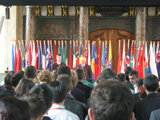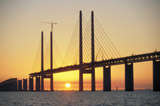|
|
Vol.
27 No. 4
July-August 2005
The International Chemistry Olympiad
by Jan Apotheker
 |
Opening ceremony of the 36th International Chemistry Olympiad, held 19 July 2004 in Kiel, Germany. |
The International Chemistry Olympiad (IChO)—a chemistry competition for secondary-school students that began in Czechoslovakia in 1968—continues to grow in size, prestige, complexity, and cost. Teams from a record 68 countries will compete at the 37th International Chemistry Olympiad, which will be held 16–25 July 2005 in Taipei, Taiwan.
The IChO tests students’ ability to solve challenging chemical problems by designing and conducting their own experiments. The Olympiads also encourage cooperation, understanding, and friendship among young people from different countries.
The following description of the 36th IChO provides an in-depth look at how these events are organized and managed, including the benefits and challenges for the host country.
On 18 July 2004, about 250 students from 61 countries descended on the University of Kiel, Germany, to participate in the 36th IChO. The students, who were accompanied by about 200 mentors, observers, and guests, were received by a team from the Institute for Pedagogy of Science, which had worked for about two years to prepare for this meeting.
The team, which was co-chaired by Reiner Demuth, Wolfgand Bünder, and Wolfgang Hampe, had to arrange for housing, transporting, and feeding about 600 people for 10 days. In addition, a committee of scientists from several universities worked for about a year to prepare a practical examination as well as a theoretical examination.
The exam committees are usually comprised of professors from different specialities and different universities, which means there is a great deal of creative power behind the problems the students encounter. Usually, the exam problems are related in some way to the host country. In addition, the scientific committees are often chaired by a renowned chemist.
 |
| Exam questions for the 32nd IChO—held in Copenhagen, Denmark in July 2000—were related to the Øresund Bridge between Denmark and Sweden. |
The scientific committee normally introduces a subject that is relevant to the organizing country: Denmark (2000) had the Øresund Bridge that connects Denmark and Sweden, India (2001) had the iron pole in New Delhi, and The Netherlands (2002) had the Delfts Blue.
The theoretical problems on the exams usually involve an array of subjects: physical chemistry, organic chemistry, inorganic chemistry, biochemistry, and theoretical chemistry. Because the range of subjects is so large, the organizing country publishes a set of preparatory problems—both practical and theoretical—on its Web site the previous January. These problems cover all subjects that will be part of the exams. The Web sites for each IChO can be located through the Web site of the international secretariat of the IChO <www.icho.sk>.
The practical exam usually has a synthesis, a quantitative analysis, and a kinetic experiment. For the exam in Kiel, the scientific committee chose to have both a qualitative and a quantitative analysis. The students had five hours to perform the experiments, which meant that they had to plan their work carefully. They are tested on both their ability to perform experiments accurately and on their time management skills. They are given some theoretical questions concerning the experiments, but these are primarily calculations and questions about the interpretation of data.
The exam committee limits the difficulty of the chemistry somewhat since the students are at the secondary school level. However, one may expect a bit more from them. The exam scores these students achieve are consistently surprising. The maximum score on an IChO exam is 100 points, but a normal first year chemistry student would score about 35 points. Usually, the mentors themselves don’t score much more than 50 to 60 points. The maximum score of the students in Kiel was 96 points, which is extraordinary.
| Synthesis of 2,2- Bis(p-phenyleneoxyacetic acid)propane |
 |
During the practical exam at the 36th IChO, participants were asked to perform a two-step reaction resulting in the synthesis of this compound more commonly known as bisphenol A bis(carboxymethyl) ether.
Practical exam, 36th IChO <www.icho.de> |
The students who score in the top 10% receive a gold medal, the next 20% receive a silver medal, while the next 30% receive a bronze medal. So, 60% of the participants receive a medal. The cut off for the medal allocation is decided by a jury comprised of the mentors.
Although some recent Nobel Prize winners had once been participants in the sister event, the Physics Olympiad, the IChO is more than just a competition to determine the best chemistry students of the year. These events are the first time that these students meet fellow students interested in the same subject. They get to know each other well, make a lot of friends, and get to tour the host country.
For most students, the IChO is the first step in a series of meetings with their peers. Usually it is also their first experience with a different culture. For some participants, it creates an opening for a university education. For example, participants from The Netherlands receive an extra grant when they start studying chemistry.
The Olympiad program is very busy, especially for the mentors. They start by inspecting the labs after the official opening. The program for a typical IChO is given in the table to the right.
During the first Olympiads, the authors of the exams were given the task of translating them into the native language of the participants. Nowadays, this is the task of the mentors. Up until the 2000 IChO in Copenhagen, the mentors translated the exams at night, sometimes not finishing until around 7 AM the next morning. In 2002 in Groningen, it was the first time that a separate day was provided for the translations. Even the English speaking nations feel a need for translation, but usually they are the first to finish!
The mentors also form the jury of the Olympiad and they decide on the final text version of the exams. This sometimes leads to heated discussions and long jury sessions. The evenings and excursions are used to teach the mentors about the host country and to exchange ideas about chemistry education. It has become a tradition for mentors to exchange national exam problems, which allows each mentor to build up a large file of suitable problems.
The Olympiad is an event that takes a lot of energy, but also creates a lot of new ideas and energy for the participants. It also provides stimulus to chemistry education in the home country of participants. Students who participate receive extra attention and have better opportunities for a university education. The teachers involved in the national committees for the IChO gain a better understanding of the level of chemistry education in their country. University professors who are involved with the Olympiads are able to get in touch with talented students interested in chemistry.
 |
| During the 34th Olympiad, one excursion was a visit to the Rijksmuseum in Amsterdam, where the students were exposed to a generous portion of Rembrandt and Hals. |
The IChOs also present some challenges. A number of countries are having difficulty with travel expenses. Participation in the IChO is relatively cheap, between USD 100 to a maximum USD 2000, depending on the number of years participating. Travel, however, is a different matter. A number of countries—for example from South America and Africa—have had problems raising the funds required.
Despite these difficulties, the number of participating countries has risen steadily during recent years. In Kiel, 61 countries participated, while 7 observed. The number of countries participating in Taiwan will be more than triple the 20 that participated in 1984 in Frankfurt, Germany.
Most European countries and quite a few Asian countries participate in the IChO. From Africa, only Egypt is participating. Kenya, Ivory Coast, and Nigeria have sent observers but are not yet ready to participate. For countries in Africa and a number of countries of the former Soviet Union, participating in the Olympiad creates financial problems. IUPAC and UNEP (United Nations Environment Programme) have indicated that they are willing to help find financial support, but these problems remain to be addressed. Talented chemistry students from these countries, in particular, could benefit immensely from the IChO.
 |
Origins of the Olympiad
It was in 1968 that the idea of an international Olympiad emerged from the former Czechoslovakia. Supported by the Ministry of Education, the Czechoslovak National Committee for the Chemistry Olympiad sent out invitation letters, to which Poland and Hungary responded. That year in June, these three countries participated in a four-day competition held in Prague. Each team had six pupils. There were four theoretical tasks and no experimental tasks.
At the second Olympiad, held in 1969 in Katowice, Poland, a five-day competition took place with four teams of five pupils each. The fourth team came from Bulgaria, while the former East Germany and Soviet Union sent observers. The competition included experimental tasks in addition to the theoretical tasks.
The Olympiad grew quickly, and included 7 countries in 1970 (plus former East Germany, Romania, Soviet Union); 9 countries in 1974 (plus Sweden and Yugoslavia); and 12 in 1975 (plus Austria, former West Germany, Belgium). In 1980, the Olympiad was held for the first time in a so-called “capitalist country,” which was Austria. With the growing numbers of participants, a permanent secretariat was established in 1982.
The host country carries most of the cost of organizing the Olympiad. As the number of participants grows, the budget for organizing each event is rising too. At the moment, it is around USD 1.5 million. Until 2010, the steering committee has found countries that are willing to host the Olympiad: In 2006 it will be in Seoul, 2007 in Latvia, 2008 in Hungary, and in 2009 it will possibly be in the UK. The future is looking good for the Olympiad!
Jan Apotheker <[email protected]> is a professor at the Institute for Mathematics and Science Education at the University of Groningen, in The Netherlands. Apotheker was chairman of the Organizing Committee for the 2002 IChO.
www.icho.sk
Page
last modified 6 June 2005.
Copyright © 2003-2005 International Union of Pure and
Applied Chemistry.
Questions regarding the website, please contact [email protected]
|